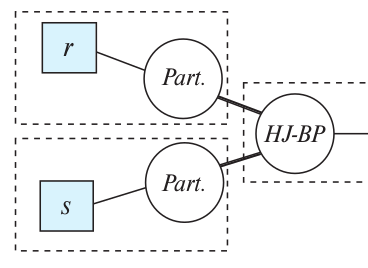15.24
Explain how to split the hybrid hash-join operator into sub-operators to model pipelining. Also explain how this split is different from the split for a hash-join operator.
Suppose we want to join the relations \(r\) and \(s\). Suppose also \(s\) is the build input and \(r\) is the probe input.
The following paragraph is taken from DSC (the book):
Hybrid hash join can be viewed as partially pipelined on the probe relation, since it can output tuples from the first partition as tuples are received for the probe relation. However, tuples that are not in the first partition will be output only after the entire pipelined input relation is received. Hybrid hash join thus provides fully pipelined evaluation on its probe input if the build input fits entirely in memory, or nearly pipelined evaluation if most of the build input fits in memory.
best-case scenario: when the build input entirely fits in memory
Read relation \(s\) into memory and create an in-memory hash index on it. Thus reading relation \(s\) is a blocking operation. Then we read in the tuples of relation \(r\) in a pipelined fashion and probe the hash index inside of main memory. If we find a match we output the result to our output-buffer.
medium-case scenario: when most of the build input fits in memory
In this case we would be fully pipelined when we get input tuples from the probe relation that also lay in the first partition. If the tuple doesn’t lay in the first partition, we have to wait/block to build and probe until constructing the partitions is done.
worst-case senario: when we have small memory
In this case the sub-operators will be identical to that of the hash-join operator.
